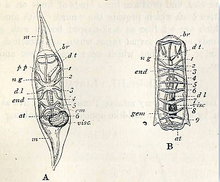| Salpa fusiformis | |
|---|---|

| |
| 1804 illustration by Georges Cuvier of Salpa fusiformis anatomy: A chain form; B solitary form; 1-9 : muscle bands; em - embryo; m - mantle; visc - visceral mass or nucleus | |
| Scientific classification | |
| Domain: | Eukaryota |
| Kingdom: | Animalia |
| Phylum: | Chordata |
| Subphylum: | Tunicata |
| Class: | Thaliacea |
| Order: | Salpida |
| Family: | Salpidae |
| Genus: | Salpa |
| Species: | S. fusiformis |
| Binomial name | |
| Salpa fusiformis Cuvier, 1804 | |
| Synonyms | |
| |
Salpa fusiformis, sometimes known as the common salp, is the most widespread species of salp. They have a cosmopolitan distribution, and can be found at depths of 0 to 800 m (0 to 2,625 ft). They exhibit diel vertical migration, moving closer to the surface at night. They can occur in very dense swarms, as solitary zooids or as colonies. Solitary zooids usually measure 22 to 52 mm (0.87 to 2.05 in) in length. They are barrel-shaped and elongated, with a rounded front and a flat rear. Aggregate zooids are 7 to 52 mm (0.28 to 2.05 in) in length individually (excluding projections). They are usually barrel or spindle-shaped.
Economic effects
The incursion of a large number of Salpa fusiformis into the North Sea in 1920 led to a failure of the Scottish herring fishery.
References
- ^ L. Madin (2014). "Salpa fusiformis Cuvier, 1804". WoRMS. World Register of Marine Species. Retrieved 21 January 2015.
- ^ Matthijs van Couwelaar (2003). "Salpa fusiformis". Zooplankton and Micronekton of the North Sea. Marine Species Identification Portal. Retrieved 21 January 2015.
- "Salpa fusiformis Cuvier, 1804". JelliesZone. Archived from the original on 28 May 2014. Retrieved 21 January 2015.
- "Salpa fusiformis". Zooplankton of the San Diego Region. Scripps Institution of Oceanography. Retrieved 21 January 2015.
- Scottish Fisheries During the War in David T. Jones; Joseph F. Duncan; H.M. Conacher; W.R. Scott (1926). Rural Scotland During the War. Oxford University Press.
| Taxon identifiers | |
|---|---|
| Salpa fusiformis | |
This tunicate-related article is a stub. You can help Misplaced Pages by expanding it. |